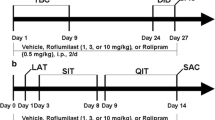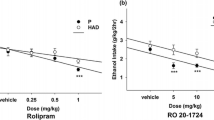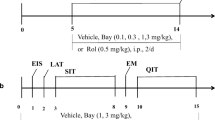Abstract
Rationale
Withdrawal symptoms stand as a core feature of alcohol dependence. Our previous results have shown that inhibition of phosphodiesterase-4 (PDE4) decreased ethanol seeking and drinking in alcohol-preferring rodents. However, little is known about whether PDE4 is involved in ethanol abstinence-related behavior.
Objective
The objective of this study was to characterize the role of PDE4 in the development of anxiety- and depressive-like behavior induced by abstinence from ethanol exposure in different animal models.
Methods
Using three rodent models of ethanol abstinence, we examined the effects of rolipram, a prototypical, selective PDE4 inhibitor, on (1) anxiety-like behavior induced by repeated ethanol abstinence in the elevated plus maze test in fawn-hooded (FH/Wjd) rats, (2) anxiety-like behavior in the open-field test and light-dark transition test following acute ethanol abstinence in C57BL/6J mice, and (3) anxiety- and depressive-like behavior induced by protracted ethanol abstinence in the elevated plus maze, forced-swim, and tail-suspension tests in C57BL/6J mice.
Results
Pretreatment with rolipram (0.1 or 0.2 mg/kg) significantly increased entries and time spent in the open arms of the elevated plus maze test in rats with repeated ethanol abstinence. Similarly, in mice with acute ethanol abstinence, administration of rolipram (0.25 or 0.5 mg/kg) dose-dependently increased the crossings in the central zone of the open-field test and duration and transitions on the light side of the light-dark transition test, suggesting anxiolytic-like effects of rolipram. Consistent with these, chronic treatment with rolipram (0.1, 0.3, or 1.0 mg/kg) increased entries in the open arms of the elevated plus maze test; it also reduced the increased duration of immobility in both the forced-swim and tail-suspension tests in mice after protracted ethanol abstinence, suggesting antidepressant-like effects of rolipram.
Conclusions
These results provide the first demonstration for that PDE4 plays a role in modulating the development of negative emotional reactions associated with ethanol abstinence, including anxiety and depression. PDE4 inhibitors may be a novel class of drugs for treatment of alcoholism.



Similar content being viewed by others
References
American Psychiatric Association (2013) Diagnostic and statistical manual of mental disorders: DSM-5., 5th ed, American Psychiatric Association,
Bell RL, Lopez MF, Cui C, Egli M, Johnson KW, Franklin KM, Becker HC (2015) Ibudilast reduces alcohol drinking in multiple animal models of alcohol dependence. Addict Biol 20:38–42
Blednov YA, Benavidez JM, Black M, Harris RA (2014) Inhibition of phosphodiesterase 4 reduces ethanol intake and preference in C57BL/6J mice. Front Neurosci 8:129
Cherry JA, Davis RL (1999) Cyclic AMP phosphodiesterases are localized in regions of the mouse brain associated with reinforcement, movement, and affect. J Comp Neurol 407:287–301
De Witte P, Pinto E, Ansseau M, Verbanck P (2003) Alcohol and withdrawal: from animal research to clinical issues. Neurosci Biobehav Rev 27:189–197
Fleischhacker WW, Hinterhuber H, Bauer H, Pflug B, Berner P, Simhandl C, Wolf R, Gerlach W, Jaklitsch H, Sastre-y-Hernandez M, Et A (1992) A multicenter double-blind study of three different doses of the new cAMP-phosphodiesterase inhibitor rolipram in patients with major depressive disorder. Neuropsychobiology 26:59–64
Gonzalez-Cuello A, Sanchez L, Hernandez J, Teresa CM, Victoria MM, Laorden ML (2007) Phosphodiesterase 4 inhibitors, rolipram and diazepam block the adaptive changes observed during morphine withdrawal in the heart. Eur J Pharmacol 570:1–9
Hamdy MM, Mamiya T, Noda Y, Sayed M, Assi AA, Gomaa A, Yamada K, Nabeshima T (2001) A selective phosphodiesterase IV inhibitor, rolipram blocks both withdrawal behavioral manifestations, and c-Fos protein expression in morphine dependent mice. Behav Brain Res 118:85–93
Hebenstreit GF, Fellerer K, Fichte K, Fischer G, Geyer N, Meya U, Sastre-y-Hernandez M, Schony W, Schratzer M, Soukop W, Et A (1989) Rolipram in major depressive disorder: results of a double-blind comparative study with imipramine. Pharmacopsychiatry 22:156–160
Hu W, Lu T, Chen A, Huang Y, Hansen R, Chandler LJ, Zhang HT (2011) Inhibition of phosphodiesterase-4 decreases ethanol intake in mice. Psychopharmacology 218:331–339
Iyo M, Bi Y, Hashimoto K, Inada T, Fukui S (1996) Prevention of methamphetamine-induced behavioral sensitization in rats by a cyclic AMP phosphodiesterase inhibitor, rolipram. Eur J Pharmacol 312:163–170
Iyo M, Maeda Y, Inada T, Kitao Y, Sasaki H, Fukui S (1995) The effects of a selective cAMP phosphodiesterase inhibitor, rolipram, on methamphetamine-induced behavior. Neuropsychopharmacology 13:33–39
Janes AC, Kantak KM, Cherry JA (2009) The involvement of type IV phosphodiesterases in cocaine-induced sensitization and subsequent pERK expression in the mouse nucleus accumbens. Psychopharmacology 206:177–185
Kim HJ, Park SD, Lee RM, Lee BH, Choi SH, Hwang SH, Rhim H, Kim HC, Nah SY (2017) Gintonin attenuates depressive-like behaviors associated with alcohol withdrawal in mice. J Affect Disord 215:23–29
Knapp CM, Foye MM, Ciraulo DA, Kornetsky C (1999) The type IV phosphodiesterase inhibitors, Ro 20-1724 and rolipram, block the initiation of cocaine self-administration. Pharmacol Biochem Behav 62:151–158
Knapp DJ, Overstreet DH, Breese GR (2007) Baclofen blocks expression and sensitization of anxiety-like behavior in an animal model of repeated stress and ethanol withdrawal. Alcohol Clin Exp Res 31:582–595
Koob GF (2003) Alcoholism: allostasis and beyond. Alcohol Clin Exp Res 27:232–243
Koob GF, Le Moal M (1997) Drug abuse: hedonic homeostatic dysregulation. Science 278:52–58
Lai M, Zhu H, Sun A, Zhuang D, Fu D, Chen W, Zhang HT, Zhou W (2014) The phosphodiesterase-4 inhibitor rolipram attenuates heroin-seeking behavior induced by cues or heroin priming in rats. Int J Neuropsychopharmacol 17:1397–1407
Lee GA, Forsythe M (2011) Is alcohol more dangerous than heroin? The physical, social and financial costs of alcohol. Int Emerg Nurs 19:141–145
Li YF, Huang Y, Amsdell SL, Xiao L, O'Donnell JM, Zhang HT (2009) Antidepressant- and anxiolytic-like effects of the phosphodiesterase-4 inhibitor rolipram on behavior depend on cyclic AMP response element binding protein-mediated neurogenesis in the hippocampus. Neuropsychopharmacology 34:2404–2419
Liddie S, Anderson KL, Paz A, Itzhak Y (2012) The effect of phosphodiesterase inhibitors on the extinction of cocaine-induced conditioned place preference in mice. J Psychopharmacol 26:1375–1382
Mizokawa T, Kimura K, Ikoma Y, Hara K, Oshino N, Yamamoto T, Ueki S (1988) The effect of a selective phosphodiesterase inhibitor, rolipram, on muricide in olfactory bulbectomized rats. Jpn J Pharmacol 48:357–364
Moonat S, Starkman BG, Sakharkar A, Pandey SC (2010) Neuroscience of alcoholism: molecular and cellular mechanisms. Cell Mol Life Sci 67:73–88
Nunez C, Gonzalez-Cuello A, Sanchez L, Vargas ML, Milanes MV, Laorden ML (2009) Effects of rolipram and diazepam on the adaptive changes induced by morphine withdrawal in the hypothalamic paraventricular nucleus. Eur J Pharmacol 620:1–8
Nutt DJ, King LA, Phillips LD (2010) Drug harms in the UK: a multicriteria decision analysis. Lancet 376:1558–1565
Overstreet DH, Knapp DJ, Breese GR (2002) Accentuated decrease in social interaction in rats subjected to repeated ethanol withdrawals. Alcohol Clin Exp Res 26:1259–1268
Overstreet DH, Knapp DJ, Breese GR (2005) Pharmacological modulation of repeated ethanol withdrawal-induced anxiety-like behavior differs in alcohol-preferring P and Sprague-Dawley rats. Pharmacol Biochem Behav 81:122–130
Overstreet DH, Rezvani AH, Djouma E, Parsian A, Lawrence AJ (2007) Depressive-like behavior and high alcohol drinking co-occur in the FH/WJD rat but appear to be under independent genetic control. Neurosci Biobehav Rev 31:103–114
Pandey SC (2003) Anxiety and alcohol abuse disorders: a common role for CREB and its target, the neuropeptide Y gene. Trends Pharmacol Sci 24:456–460
Pandey SC (2004) The gene transcription factor cyclic AMP-responsive element binding protein: role in positive and negative affective states of alcohol addiction. Pharmacol Ther 104:47–58
Pandey SC, Roy A, Zhang H (2003) The decreased phosphorylation of cyclic adenosine monophosphate (cAMP) response element binding (CREB) protein in the central amygdala acts as a molecular substrate for anxiety related to ethanol withdrawal in rats. Alcohol Clin Exp Res 27:396–409
Pandey SC, Zhang H, Roy A, Xu T (2005) Deficits in amygdaloid cAMP-responsive element-binding protein signaling play a role in genetic predisposition to anxiety and alcoholism. J Clin Invest 115:2762–2773
Pérez-Torres S, Miró X, Palacios JM, Cortés R, Puigdoménech P, Mengod G (2000) Phosphodiesterase type 4 isozymes expression in human brain examined by in situ hybridization histochemistry and[3H]rolipram binding autoradiography. Comparison with monkey and rat brain. J Chem Neuroanat 20(3-4):349–374
Porsolt RD, Anton G, Blavet N, Jalfre M (1978) Behavioural despair in rats: a new model sensitive to antidepressant treatments. Eur J Pharmacol 47:379–391
Rezvani AH, Overstreet DH, Cleves M, Parsian A (2007) Further genetic characterization of the fawn-hooded (FH/Wjd) rat, an animal model of comorbid depression and alcoholism. Psychiatr Genet 17:77–83
Rezvani AH, Parsian A, Overstreet DH (2002) The fawn-hooded (FH/Wjd) rat: a genetic animal model of comorbid depression and alcoholism. Psychiatr Genet 12:1–16
Silvestre JS, Fernandez AG, Palacios JM (1999) Effects of rolipram on the elevated plus-maze test in rats: a preliminary study. J Psychopharmacol 13:274–277
Steru L, Chermat R, Thierry B, Simon P (1985) The tail suspension test: a new method for screening antidepressants in mice. Psychopharmacology 85:367–370
Stevenson JR, Schroeder JP, Nixon K, Besheer J, Crews FT, Hodge CW (2009) Abstinence following alcohol drinking produces depression-like behavior and reduced hippocampal neurogenesis in mice. Neuropsychopharmacology 34:1209–1222
Thompson BE, Sachs BD, Kantak KM, Cherry JA (2004) The type IV phosphodiesterase inhibitor rolipram interferes with drug-induced conditioned place preference but not immediate early gene induction in mice. Eur J Neurosci 19:2561–2568
Wachtel H (1983) Potential antidepressant activity of rolipram and other selective cyclic adenosine 3′,5′-monophosphate phosphodiesterase inhibitors. Neuropharmacology 22:267–272
Wen RT, Zhang M, Qin WJ, Liu Q, Wang WP, Lawrence AJ, Zhang HT, Liang JH (2012) The phosphodiesterase-4 (PDE4) inhibitor rolipram decreases ethanol seeking and consumption in alcohol-preferring fawn-hooded rats. Alcohol Clin Exp Res 36:2157–2167
Wills TA, Knapp DJ, Overstreet DH, Breese GR (2009) Sensitization, duration, and pharmacological blockade of anxiety-like behavior following repeated ethanol withdrawal in adolescent and adult rats. Alcohol Clin Exp Res 33:455–463
Yoneyama N, Crabbe JC, Ford MM, Murillo A, Finn DA (2008) Voluntary ethanol consumption in 22 inbred mouse strains. Alcohol 42:149–160
Zeller E, Stief HJ, Pflug B, Sastre-y-Hernandez M (1984) Results of a phase II study of the antidepressant effect of rolipram. Pharmacopsychiatry 17:188–190
Zhang C, Cheng Y, Wang H, Wang C, Wilson SP, Xu J, Zhang HT (2014) RNA interference-mediated knockdown of long-form phosphodiesterase-4D (PDE4D) enzyme reverses amyloid-beta42-induced memory deficits in mice. J Alzheimers Dis 38:269–280
Zhang HT (2009) Cyclic AMP-specific phosphodiesterase-4 as a target for the development of antidepressant drugs. Curr Pharm Des 15:1688–1698
Zhang HT, Huang Y, Jin SL, Frith SA, Suvarna N, Conti M, O'Donnell JM (2002) Antidepressant-like profile and reduced sensitivity to rolipram in mice deficient in the PDE4D phosphodiesterase enzyme. Neuropsychopharmacology 27:587–595
Zhang HT, Huang Y, Masood A, Stolinski LR, Li Y, Zhang L, Dlaboga D, Jin SL, Conti M, O'Donnell JM (2008) Anxiogenic-like behavioral phenotype of mice deficient in phosphodiesterase 4B (PDE4B). Neuropsychopharmacology 33:1611–1623
Zhong P, Wang W, Yu F, Nazari M, Liu X, Liu QS (2012) Phosphodiesterase 4 inhibition impairs cocaine-induced inhibitory synaptic plasticity and conditioned place preference. Neuropsychopharmacology 37:2377–2387
Acknowledgements
This work was supported by research grants from the National Nature Science Foundation of China (81373384, to J-PX; 81503050, to R-TW; and 30870894, to J-HL), the Natural Science Foundation of Zhejiang Province, China (LY14H310012; to J-CP), the Foundation of Overseas Distinguished Taishan Scholars of Shandong Province (to H-TZ), and China and US NIH/NIAAA (AA020042; to H-TZ).
Author information
Authors and Affiliations
Corresponding authors
Rights and permissions
About this article
Cite this article
Gong, MF., Wen, RT., Xu, Y. et al. Attenuation of ethanol abstinence-induced anxiety- and depressive-like behavior by the phosphodiesterase-4 inhibitor rolipram in rodents. Psychopharmacology 234, 3143–3151 (2017). https://doi.org/10.1007/s00213-017-4697-3
Received:
Accepted:
Published:
Issue Date:
DOI: https://doi.org/10.1007/s00213-017-4697-3




